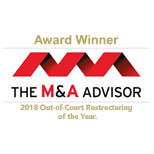In Part 1, we outlined three ways an investment banking firm assists in adding value in M&A transactions. We will now discuss the basic components of deal structure in M&A transactions.
The Importance of Cash in M&A Transactions
The old adage “cash is king” is an old cliche, but a good guideline when negotiating M&A transactions. If you have owned a business for many years, you have an illiquid asset. Selling your business is likely to create the biggest liquidity event you in your life.
An offer of cash upfront is the most secure consideration you can receive. While publicly traded companies often create intricate deal structures that are heavy on stock considerations, for the lower- to middle-market, the majority of any deal will typically be front-loaded with cash.
Rollover Equity
Depending on your objectives, you may be content to rollover equity as part of the purchase price. If you plan to stay on board in the new company, this gives you a financial interest in the business. If the buyer is a private equity firm that sells the company again in the future, this could provide you with a “second bite of the apple.” In many cases, the second or third time selling an equity stake could provide a greater value than the first sale transaction even though your equity percentage may be lower. It should also be noted that if the seller is willing to take equity as part of a transaction, the seller’s desire to retain equity will typically be viewed positively by the buyer as it demonstrates the seller’s belief in the future growth of the business.
What About Seller Notes?
A deal structure that involves a seller note will contain a debt component from the seller. Along with receiving cash or other considerations being offered, you would assume a portion of the purchase price as a note on the business to increase the valuation. The terms of a seller note will vary from one transaction to another. One common factor, however, is that an offer with a seller note often gives a buyer more flexibility in their price. If the two parties are having trouble agreeing on a purchase price, a seller note can be an excellent strategy to make the buyer comfortable with paying a higher price.
Understanding Earnouts
If an owner wants to stay involved in the business, an earnout may be negotiated into the purchase agreement. Earnouts are considerations that will contain specific revenue, EBITDA, or other targets that will be applicable over the period of time you remain with the business. If those targets are met, you will receive compensation for meeting them. Again, earnouts are an excellent way to keep owners who are key to the business focused on the financial performance of the business after a sale.
How Deal Structure Adds Value to M&A Transactions
How do all of these components come together for the perfect deal structure and value? There is no one right answer to this question, as every deal will depend on the owner/seller’s goals and objectives. If you simply want to sell and retire or move on, it may be more attractive to receive a lower value that involves mostly cash upfront. Meanwhile, if you would like to sell but stay involved in some form as well as benefit from the upside of the business, you may be able to negotiate a higher price by agreeing to hold equity in the business, accepting an earnout, or holding a seller note.
If you are thinking about selling, the most important step you can take is working to understand what a potential buyer would want and creating a strategy to get your business there. The team at MelCap can help with this kind of planning months or even years before you plan to sell. With these goals and financials in mind, you will be on the path to crafting the perfect deal structure to ensure maximum value in M&A transactions.















